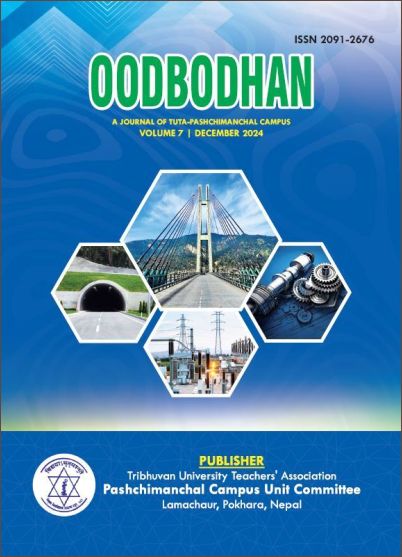A Review of Various Landslide Susceptibility Mapping Techniques Used in Nepal
DOI:
https://doi.org/10.3126/oodbodhan.v7i1.75762Keywords:
Analytical Hierarchy Process, Artificial Neural Network, Frequency Ratio, Landslide, Landslide susceptibility, Logistic Regression, Weight of EvidenceAbstract
A landslide is one of the most destructive geological hazards in Nepal. For systematic mitigation and management of landslide, comprehensive landslide evaluation and hazard zonation are essentially needed. During recent decades, various susceptibility mapping methods have been applied to identify landslide-prone areas in Nepal. This review article analyzes the strengths, limitations, and effectiveness of methods such as Frequency Ratio (FR), Weight of Evidence (WoE), Analytical Hierarchy Process (AHP), Logistic Regression (LR), and Artificial Neural Networks (ANN), in mapping landslide susceptibility and underlines significant research gaps through a review of various past studies from Nepal. FR and WoE are user-friendly, but they require extensive historical data, whereas AHP relies on expert judgment without the need for previous information. LR and ANN are very accurate and reliable but are resource-intensive. There is a great research gap that needs to discuss how factors such as local conditions, selection of training data, and data quality interact to influence the effectiveness of the methods and lead to different predictions in different areas. Further, the models also do not incorporate some vital parameters like groundwater modelling and soil depth that are very crucial for improvement of accuracy and interpretation of landslide dangers. Finally, suitable models need to be employed so that a critical study of susceptibility can be conducted and landslide management strategies can be more effective.
Downloads
Downloads
Published
How to Cite
Issue
Section
License
Copyright (c) 2024 The Author(s)

This work is licensed under a Creative Commons Attribution-NonCommercial-NoDerivatives 4.0 International License.
This license enables reusers to copy and distribute the material in any medium or format in unadapted form only, for noncommercial purposes only, and only so long as attribution is given to the creator.




